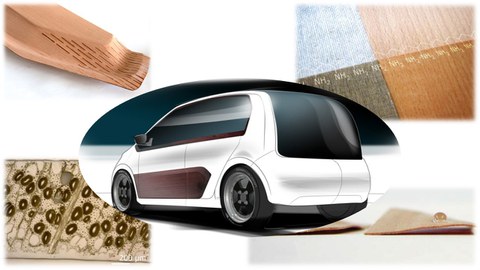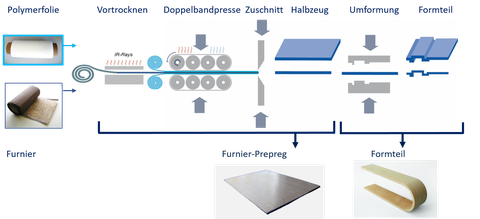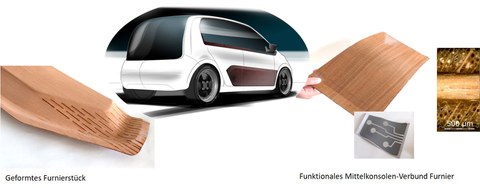Nov 01, 2012
MERGE - DFG Cluster of Excellence

Materials/samples around the Chemnitz ConceptCar in the DFG Cluster of Excellence MERGE
Cluster of Excellence - Technologies for Multifunctional Lightweight Structures
|
Duration |
11/12 - 10/19 |
|
Funding by |
BMBF | DFG |
|
Funding code |
Cluster of Excellence, EXC 1075 |
|
Contact |
|
|
Keywords |
Lightweight construction, natural materials, veneer, biopolymer |
The aim of research in Germany's first federal cluster of excellence in the field of lightweight construction research was technology fusion for multifunctional lightweight structures. In other words, the fusion of basic technologies suitable for large-scale production from the fields of plastics, metal, textiles and smart systems for the development of resource-efficient products and production processes.
Over 100 scientists and technicians from a total of six interacting research fields conducted research into technology fusion for the production of multifunctional lightweight structures for large-scale production.
The research field "Textile/plastic-based technologies" was dedicated to the development of processes for the series production of continuous fiber-reinforced lightweight structures. To this end, plastic processing methods based on thermoplastic polymers such as injection moulding and pressing technologies were further developed and optimized, for example with integrated textile reinforcements. In addition to the parallel processing of several plastics, it was also possible to incorporate metallic and electronic components directly into the parts so that hybrid components could be produced efficiently and without complex joining processes. In order to promote environmentally friendly and resource-saving production in terms of sustainability, natural fibers as well as bio-based and biodegradable plastics were used.
Sub-project of the Chair of Wood Technology and Fiber Materials Technology
The aim of the natural material technology research approaches at TU Dresden was to develop sustainable products for lightweight construction. These new bio-based composite materials consist of natural fiber-reinforced bio-based thermoplastics. The TUD investigated the bionic approach of using the undestroyed natural fiber composite of wood - in this case thin wood veneers - as fiber reinforcement. Wood species and veneer thicknesses were varied. Wood-friendly process parameters for processing veneers and thermoplastic films were investigated. Bio-based adhesion promoters were developed together with the project partners.

Prozesskette Halbzeug
In addition, the veneer thermoplastic semi-finished products developed were processed into exemplary products using various shaping processes. This ensured overall process suitability. Finally, components for the interior and exterior of the VW UP were created in the overall demonstrator, whereby sensor integration could also be mapped.

Bildcollage Produkte
- Evaluation of the bonding behaviour of thin bio-based wooden laminates
- Aqueous Poly (N-Vinylformamide-Co-Vinylamine) as a suitable adhesion promoter for wood veneer/biopolyethylene composite materials
- Natural unidirectional sheet processes for fibre reinforced bioplastics
- Maleic anhydride copolymers as adhesion-promoting reagent in wood veneer/biopolyethlyene composite materials
- Textil-/Kunststoffverarbeitungsverfahren mit nachwachsenden Rohstoffen S. 371 - 393
- Textil-/Kunststoffverarbeitungsverfahren mit nachwachsenden Rohstoffen; S. 419 - 439

